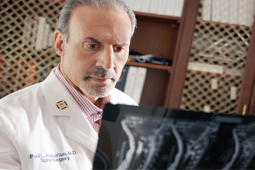
Spinal fusion is a surgical procedure used to correct problems with the small bones in vertebrae. The basic idea is to fuse together the painful vertebrae so that they heal into a single, solid bone. In a posterior approach to lumbar fusion, the surgeon makes an incision down the middle of the lower back. To see the vertebrae, the surgeon will pull back the muscles that surround the spine and remove any pressure from nearby nerves. Graft material is then placed along the sides of the vertebrae to stimulate bone growth. Titanium screws and rods are often used to provide immediate stability to the spine until a solid fusion has been achieved.
Related conditions
Spondylolisthesis (stress fracture causing vertebrae to slip out of position)
In spondylolisthesis, one of the vertebra in the spine slips forward and out of place. This may occur anywhere along the spine, but is most common in the lower back.
Spinal stenosis
A common cause of lower back and leg pain is lumbar spinal stenosis. As we age, our spines change. The normal effects of aging can lead to narrowing of the spinal canal. This condition is called lumbar stenosis, or lumbar spinal stenosis.
Our providers
Location: Change location Enter your location
Spine Surgery
-
Amjad Nasr Anaizi, MD
Neurosurgery, Vascular Neurosurgery, Neurosurgical Oncology, Spine Surgery, Brain and Tumor Neurosurgery & Skull Base Surgery
-
Vinay R. Deshmukh, MD
Spine Surgery & Neurosurgery
-
Zeena Dorai, MD
Spine Surgery & Neurosurgery
-
Mark Iguchi, MD
Spine Surgery & Neurosurgery
-
Akhil Jay Khanna, MD
Spine Surgery
-
Mesfin A. Lemma, MD
Spine Surgery
-
John Lynes, MD
Spine Surgery, Brain and Tumor Neurosurgery & Neurosurgery
-
Jeffrey Ching-Kwei Mai, MD,PhD
Skull Base Surgery, Neurosurgery, Vascular Neurosurgery, Endovascular Neurosurgery & Spine Surgery
-
Paul C. McAfee, MD
Spine Surgery
-
Addisu Mesfin, MD
Spine Surgery
-
Andrew Zhan Mo, MD
Spine Surgery
-
Faheem Akram Sandhu, MD
Spine Surgery & Neurosurgery
-
Oliver Tannous, MD
Spine Surgery
-
Jean-Marc Voyadzis, MD
Spine Surgery & Neurosurgery
-
David A Weiner, MD
Spine Surgery
-
Teresa Wojtasiewicz, MD
Spine Surgery & Neurosurgery









